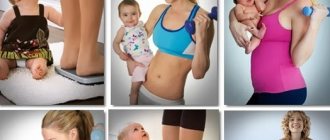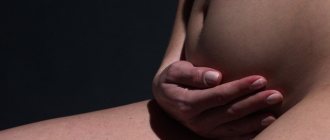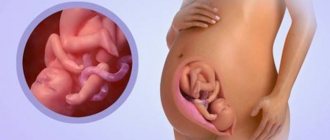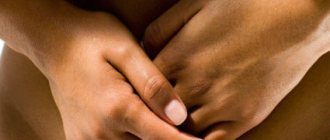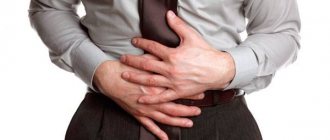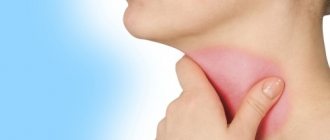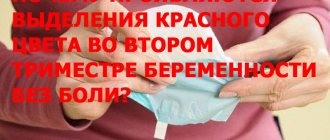Possible causes of pain, its characteristics, accompanying symptoms
Painful sensations in the tailbone are called coccydynia. There is also pseudococcydynia, when pain is caused by pathologies in the field of gynecology, urology or proctology. There may be several causes of pain in the tailbone after childbirth.
Injury
This can happen during natural childbirth due to pressure on the birth canal. The reason may be the large size of the baby, incorrect presentation, too narrow pelvis or its irregular shape.
The most serious injury is a fractured coccyx. In this case, severe pain occurs, which intensifies in a sitting position, during bowel movements, especially if there are problems with bowel movements.
The fracture is also accompanied by other signs:
- local swelling;
- hyperemia;
- increased sensitivity;
- difficulty moving.
Coccyx extension
This phenomenon occurs naturally during childbirth, as it allows the birth canal to be enlarged so that the baby can pass through it. If the fetus is too large, the tailbone may tilt back significantly. In this case, painful sensations arise.
The condition usually returns to normal within a few weeks after birth.
Prolapse of the genital organs
This problem can affect the vaginal walls, cervix or uterine body. In this case, a nagging pain and heaviness may be felt in the area of the tailbone and lower back. There may be a feeling of a foreign body or distension in the vagina.
Painful sensations may increase with prolonged standing on your feet. In the morning, the symptoms are less pronounced, and when lying down they may disappear completely.
Prolapse of the genital organs may be accompanied by the following symptoms:
- difficulty urinating;
- stagnation in the urinary system, which is fraught with the development of infection;
- stress incontinence;
- disruption of the colon: cramping abdominal pain, alternating constipation with diarrhea, incontinence of feces and gases;
- discomfort during sexual intercourse;
- pain during menstruation, increased volume of menstrual blood.
Pinched nerve
This pathology is accompanied by pain in the coccyx and lumbar region, which intensifies with palpation and prolonged sitting, especially on hard surfaces.
The pain may also intensify if you stand or lie on the coccygeal bone for a long time. Painful sensations become stronger with constipation, subsiding after bowel movements.
Osteochondrosis
This pathology can worsen during childbirth. It means degenerative-dystrophic changes and damage to cartilage tissue.
The disease is characterized by painful sensations in the tailbone. Other symptoms are also observed:
- impaired gait;
- frequent constipation;
- improper functioning of the colon, causing intestinal irritation;
- depression, anxiety.
Endometritis
This name hides an inflammatory process that affects the surface layer of the endometrium (the inner mucous membrane of the uterine body). The nature of this disease is often infectious.
Endometritis develops quickly. The pain is usually localized in the pelvis and can be either mild nagging or unbearably sharp. It can radiate not only to the tailbone, but also to the sacrum, lower back, groin area, and rectum.
The pathology is accompanied by other symptoms:
- secretion of mucus, sometimes pus;
- pain on palpation of the uterus;
- possible bleeding;
- With an intestinal infection, an unpleasant odor is observed.
Haemorrhoids
This pathology often worsens during pregnancy and after childbirth. This disease involves thrombosis, inflammation, pathological expansion and tortuosity of hemorrhoidal veins.
The pain can be localized in the lower abdomen, in the rectum, or radiate to the tailbone. Painful sensations worsen during and after defecation, with prolonged sitting.
The pathology may also be accompanied by the following signs:
- spotting after bowel movements - at the initial stage they are noticeable only on toilet paper;
- feeling of intestines not being completely emptied;
- discomfort in the anorectal area, burning, itching;
- As the disease progresses, prolapse of hemorrhoids is observed, which at the last stage cannot be reduced without surgery.
Why does pain occur?
Why does the tailbone hurt after childbirth? Pain on the tailbone after childbirth occurs for the following reasons:
- due to pinched nerve in the area of the sacrum and coccygeal bone. This is how pain on the coccygeal bone often appears after childbirth.
- With a strong deviation of the coccygeal bone back, when the child walked through the birth canal (usually a large baby). In general, the tailbone always extends during childbirth. This is necessary to thicken the birth canal and, accordingly, for the easy birth of the baby.
- Due to postpartum prolapse of the perineum, which also leads to coccygeal pain. Women suffer from a similar cause of coccyx pain after undergoing a difficult birth.
- During birth trauma of the perineum. Thus, hemorrhage occurs in the area of the coccyx, sacrum, and then pain occurs and a bruise forms.
- Due to damage to the ligaments that are located near the coccygeal bone. This is rare during childbirth, but it does happen.
- In case of a birth fracture (dislocation) of the damaged coccyx. This happens very rarely, with very difficult births.
Diagnostics
Diagnosis of pain in the tailbone begins with a standard examination. A vaginal or rectal examination may be performed.
To complete the clinical picture, general urine and blood tests are performed. In some cases, specific studies may be required.
Among the methods of instrumental diagnostics, X-rays and ultrasound scanning are most often used. The latter can be carried out transvaginally or transrectally for greater information content. Other diagnostic methods may also be required:
- CT scan;
- Magnetic resonance imaging;
- colonoscopy.
Measures being taken
Many people wonder what to do if their tailbone hurts after childbirth: they want to quickly get rid of these unpleasant sensations that prevent them from enjoying life. If the nature of their origin is normal postpartum recovery of the body without serious injury, it can be accelerated independently, without the help of doctors. Following a few basic tips will allow you to forget about unpleasant and painful sensations very quickly.
- If you are sure that there are no serious injuries, do gymnastics on the ball.
- A set of special exercises designed to restore the body after childbirth will also help.
- In the first month after the birth of the baby, if your tailbone hurts, you should not lift anything heavy.
- It is better to sleep on an orthopedic mattress.
- Do not try to relieve pain by sitting on soft pillows: this will only make the situation worse.
- It is better to lie down more: when you sit or walk a lot, the load increases the pain.
- To improve blood supply in this area, with the permission of a doctor, you can use locally irritating tinctures - an alcohol solution of lilac or hot pepper. Gauze or cotton compress is generously moistened with healing liquid and applied to the problem area. Cover the top with a plastic bag and tie it to your back for 1.5-2 hours. This remedy is especially good for pinching the sciatic nerve. However, before using it at home, it is better to consult a specialist.
- In the first 2 days after birth, apply cold compresses (with ice) to the tailbone area to relieve swelling.
- Follow a diet: you will need foods rich in fiber in your diet.
- If the tailbone hurts due to a lack of calcium in the body, you urgently need to replenish it: eat more dairy products or take a course of special calcium-containing drugs (during lactation, this can only be done with the permission of a doctor).
- Drink more water to avoid constipation, which will only increase the load on your injured tailbone.
- Experts advise sitting only in certain positions: on your side; on an orthopedic pillow; on a small stool so that the tailbone does not rest on the seat, but hangs from the back; on a “perch” made from a rolled towel; leaning your body forward and leaning on your elbows.
- If you still have pain after 3 weeks after giving birth, make an appointment with your doctor.
Usually, within 1-2 weeks, if these recommendations are followed, the discomfort disappears. If you feel that your tailbone hurts for a suspiciously long time and severely after childbirth, it is better not to risk it, but to immediately seek professional help from a specialist.
Treatment of pain in the tailbone after childbirth
If you experience pain in your tailbone, you should definitely consult a doctor. Only he can prescribe adequate treatment, the specifics of which depend on the cause of the unpleasant symptoms. In some cases, the body recovers on its own, in others the use of medications, physiotherapy, and physical therapy may be required. In severe cases, surgical treatment is resorted to.
Drug therapy
Treatment of pain in the tailbone depends on the causes that caused it. The following medications may be needed:
- Non-steroidal anti-inflammatory drugs. More often they resort to Diclofenac, Ibuprofen, Celecoxib, Celebrex. Such medications are good at relieving inflammation and eliminating pain.
- For the same purpose, they resort to glucocorticosteroids. They are prescribed when non-steroidal anti-inflammatory drugs are ineffective.
- Analgesics. In cases of unbearable pain, they resort to drugs of narcotic origin.
- Antibiotics. Such medications are usually prescribed when the disease is infectious or has a secondary infection. In most cases, antibacterial therapy begins with broad-spectrum drugs.
- Muscle relaxants for muscle relaxation.
- Vitamin and mineral complexes.
- For hemorrhoids, they resort to antihemorrhoidal drugs in the form of rectal suppositories or cream (ointment).
Many medications are contraindicated for use during breastfeeding. A specialist should prescribe suitable medications. In some cases, it is necessary to consider stopping lactation.
Physiotherapy, exercise therapy
This direction of treatment is necessary to eliminate pain, relieve inflammation, and accelerate the recovery process. For pain in the tailbone, the following procedures may be prescribed:
- electro- and phonophoresis with medications;
- ultrasound therapy;
- UV radiation;
- cryotherapy;
- diadynamic therapy;
- UVT therapy;
- magnetic therapy;
- paraffin applications.
For recovery purposes, they also resort to therapeutic exercises. It is performed under the supervision of a specialist, but some exercises can be done at home after prior consultation with your doctor.
Help with a fracture
In the event of such an injury, a woman needs a state of rest. Mobility should be limited as much as possible. Cold is applied to reduce swelling and pain.
You should avoid contact of your tailbone with any surfaces and sit less. You can lie on your stomach or side.
Treatment of a fracture may involve the following measures:
- with an open fracture - stopping bleeding, treating the wound and preventing shock;
- with a closed fracture – elimination of pain and swelling;
- local analgesics during the first days;
- cleansing enemas to avoid displacement;
- in case of improper fusion - surgical intervention;
- taking calcium-containing medications;
- physiotherapy.
During the recovery period after a fracture, it is necessary to use a special pillow that redistributes the load. The following measures must also be taken:
- lean forward when sitting;
- do not sit on too soft surfaces;
- in a sitting position, move the load from one buttock to another;
- drink more fluids;
- use mild laxatives;
- enrich your diet with foods containing calcium, vitamin D and silicon.
Treatment for genital prolapse
In case of minor deviations, no measures are taken - the body recovers on its own. In other cases, conservative or surgical treatment is necessary:
- installation of uterine rings;
- hysteropexy;
- colporrhaphy;
- perineoplasty;
- plastic with a free synthetic loop;
- vaginal extirpation (the uterus is completely removed).
ethnoscience
If you experience pain in the tailbone after childbirth, you can use some folk remedies:
- Applying an iodine mesh to the affected area, if the skin in this area is not damaged.
- Rub fir oil into the affected area three times a day.
- A compress of valerian infusion helps a lot. You can make it yourself or use a ready-made product from the pharmacy. You need to moisten a cotton cloth in the composition and apply it to the affected area. The compress must be covered with polyethylene and insulated.
- Compresses with geranium decoction are effective. To do this you need to steam 2 tbsp. l. raw materials with a liter of boiling water, keep on low heat for 7 minutes and leave for half an hour. Strain the resulting mixture, moisten a cotton cloth in it and apply to the affected area. The compress must be insulated. It's better to do it at night.
- Geranium decoction can also be used for healing baths.
- A mixture of vinegar and honey has a good analgesic effect. They need to be mixed in a 1:2 ratio. The resulting composition should be rubbed into painful areas.
The natural origin of the products does not exclude the presence of contraindications. Some ingredients may cause individual intolerance, so treatment should be started with caution.
When to see a doctor
Postpartum coccyx injury may not come to the doctor's attention. The swelling and pain from the stretch are, to some extent, masked by postpartum swelling and discomfort. Health workers do not always pay attention to the complaints of a young mother and may send the woman home without providing assistance. Like, it will go away on its own after time. Over time, the acute inflammation subsides, the pain goes away and everything seems to fall into place.
This happens in most cases when the displacement of the bones was insignificant. With more serious injuries, the vertebrae cannot independently return to their places and, accordingly, perform their previous functions. Overstrain occurs in the sacrococcygeal ligament.
Here it is necessary to remember that the musculoskeletal system is a single system and a violation in one link entails disturbances in other departments.
Thus, over time, a woman may begin to experience pain in the buttock and/or pain along the sciatic nerve. Pain syndrome changes muscle tone and causes spasms, which leads to further disorders of the musculoskeletal system and even greater problems. Therefore, if:
- the pain is severe
- pain bothers the woman for more than 2 weeks
- localization of pain in the buttock
- pain along the sciatic nerve
- there is stretching of the symphysis pubis
You should seek medical help. Most often, treatment will be conservative - returning the bones to their proper place using manual therapy and medications to relieve pain and inflammation. Moreover, it is quite possible to choose drugs that are safe for breastfeeding. And, only in the most severe situations, surgical treatment is indicated.
Prevention
To avoid pain in the tailbone after childbirth, you should think about prevention during pregnancy, as well as at the planning stage:
- strengthening the immune system;
- proper nutrition and tracking weight gain;
- special gymnastics for pregnant women;
- Kegel exercises to strengthen the pelvic floor muscles;
- use of a support bandage, especially in the last months of pregnancy;
- taking vitamin and mineral complexes for pregnant women;
- sufficient physical activity: you need to take more walks in the fresh air, walk, and engage in sports approved by your doctor.
If you have pain in the tailbone after childbirth, this symptom cannot be ignored. It may be a sign of a serious pathology. You need to consult a specialist to find out the exact cause of the pain. Only a doctor can prescribe adequate treatment in a particular case.
In what situations does pain occur?
During childbirth, a variety of physiological changes occur in the female body.
When the pelvic bones move apart, the coccygeal bone sometimes gets affected. Therefore, after childbirth, the tailbone hurts a lot.
A young patient feels pain on her tailbone in the following situations:
- with prolonged sitting. When sitting on the tailbone, the pain becomes more acute,
- when you stand up abruptly, your tailbone also hurts,
- when lying on the bed, on the back - on the spine after childbirth,
- when going to the toilet "in a big way". During childbirth, the tailbone sometimes breaks, and unpleasant ailments become more acute. They last around the clock. Similar pains radiate to the groin.
Thus, it becomes difficult for a young mother to care for her baby because she constantly feels the above-mentioned painful symptoms.
How to speed up recovery
- It is recommended to spend the first two days with warm compresses on problem areas. They will help relieve swelling.
- Also, do not forget about your diet: drink a lot of water and eat an unlimited amount of vegetables, fruits, berries, grains and legumes. This will help improve bowel function and avoid constipation, which is typical for this period.
- The next step is to limit activity and adhere to strict bed rest for several days.
- It is better to sit on your side, on a low stool, on a special pillow, on an orthopedic cushion, or leaning on your elbows.
- It is forbidden to stay on soft surfaces. This will significantly worsen the situation.
- A consultation with a doctor will help you choose the right treatment, consisting of the right medications, vitamin complexes and additional procedures.
- After complete recovery, it is suggested to perform vertebral stretching exercises and train your muscles.
When a new mother’s tailbone hurts after childbirth while sitting, this is the first signal that the body is experiencing disturbances and requires outside help. The woman herself can provide such assistance if she adheres to bed rest, leads a healthy lifestyle, follows a specially selected diet, does not lift anything heavy, applies compresses and performs light exercises. If you notice that there is no improvement, it is strongly recommended to visit a doctor after a couple of weeks.
Once you know your diagnosis and receive recommendations for treatment, recovery will happen much faster. A surgeon or traumatologist may prescribe x-rays or other manipulations if your tailbone hurts very much when you sit.
Girls are often susceptible to certain complications after their baby is born. This is how the body protests, signaling that it is not able to work as before, and it takes time to resume all functions. Some unpleasant phenomena can be eliminated quickly and without additional intervention, and certain ailments require the help of a specialist.
This problem occurs often; many mothers complain of a burning tingling sensation in the lower back. If the diagnosis is not made in time, there is the prospect of a number of difficult-to-treat consequences in the future. You should be attentive to your well-being and condition. After all, a mother’s care for her own health is very important in this rather difficult period of life.

